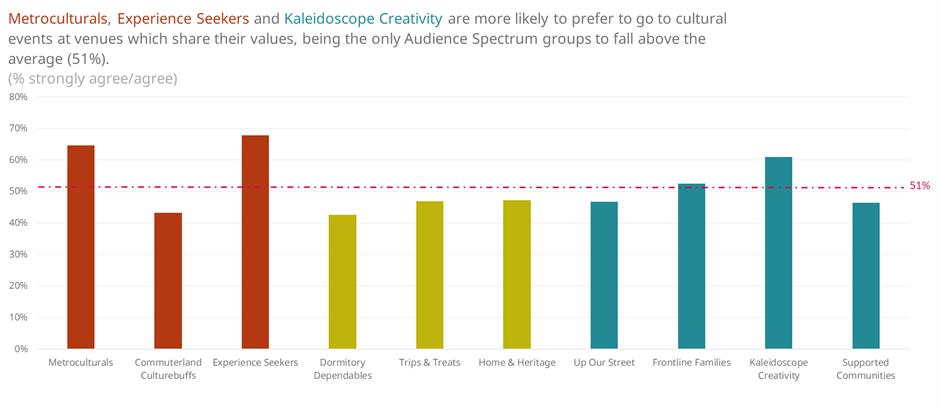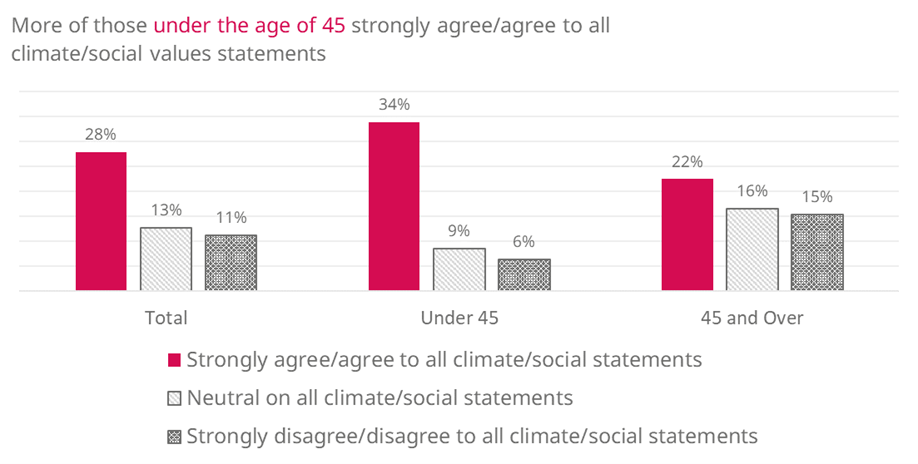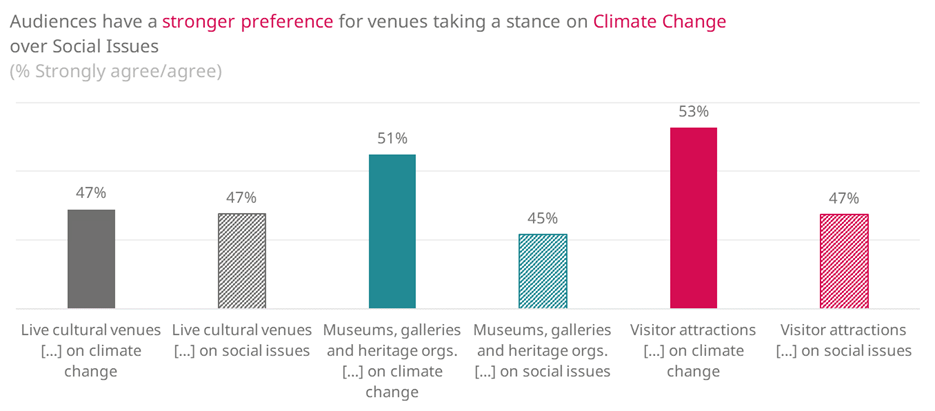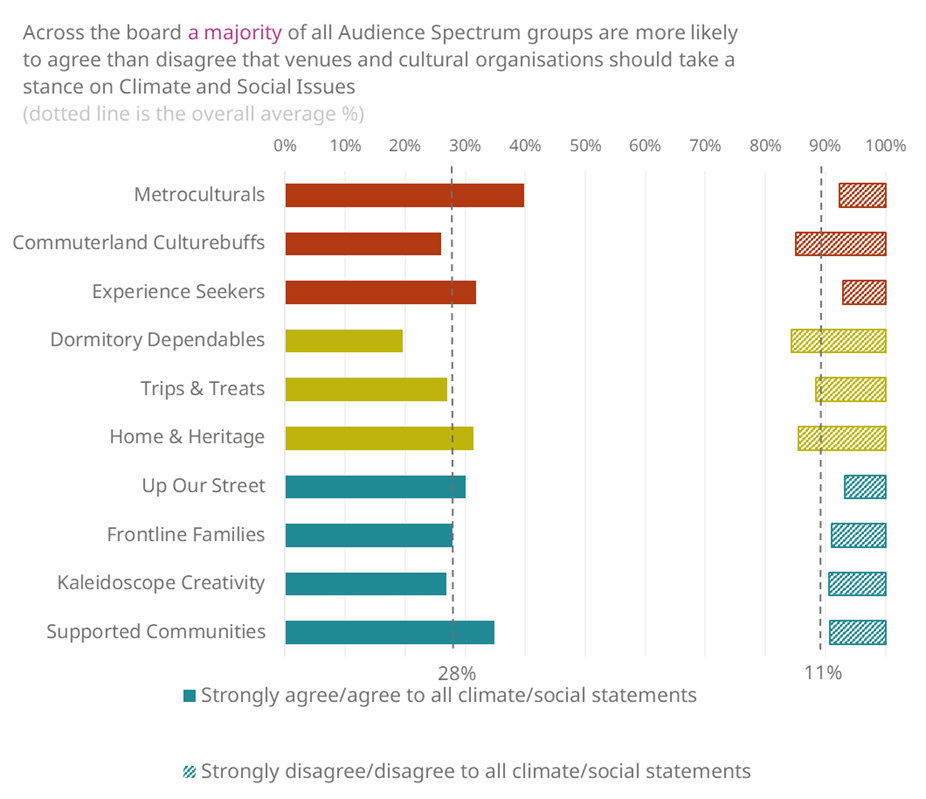Audience preferences on venues' values
November 2023
This research is from The Audience Agency's nationwide longitudinal (ongoing) panel survey of changing views about participating in creative and cultural activities through the recent and ongoing crises, and beyond, the Cultural Participation Monitor.
Themes
Social and environmental issues are at the forefront of much news about the cultural sector recently: cancellation of fossil fuel sponsorships; repatriation of museum artefacts and decolonialisation of collections and displays; demonstrations of support for Black Lives Matter; the emphasis on environmental action in Let’s Create and National Portfolio funding, to name but a few topics. But where is the voice of the audience in these discussions?
Most cultural organisations succeed or fail based on their ability to engage audiences; and audience views on these topics can be varied, strongly held, different between groups and are also changing. This creates uncertainty for organisations. Whether to pin their colours to the mast, or to try not to rock the boat. Whether attempts to be inclusive could be alienating some visitors. Whether – if they do want to take a stand – audiences already want or expect it or may need some persuading.
This report draws on findings from wave 9 of the Cultural Participation Monitor to understand how important a venue sharing their values is to audiences, and whether venues taking a stance on social and environmental issues affects people’s likelihood of attending.
People want to go to venues that share their values
We asked respondents the extent to which they agreed or disagreed with the following statements about whether venues they attend should take a stance on climate change and social issues and whether they prefer to go to venues which share their values.
a. I prefer to go to cultural events at venues which I know share my values
b. Live cultural venues should take a stance on climate change
c. Live cultural venues should take a stance on social issues
d. Museums, galleries and heritage organisations should take a stance on climate change
e. Museums, galleries and heritage organisations should take a stance on social issues
f. Visitor attractions should take a stance on climate change
g. Visitor attractions should take a stance on social issues

Younger people have a greater preference
The overall preference for a match in values was much stronger for younger people, with over 60% of those aged 16-44 agreeing (or strongly agreeing). Broken down further, it was 65% of 16–24 year-olds and 61% of 25-44 year-olds. Furthermore, over 50% of these individuals either strongly agree or agree that those venues should take a stance on social and climate change issues as well.
However, when considering Audience Spectrum groups alone, Metroculturals, Experience Seekers and Kaliedoscope Creativity, are the only groups which were above average. This suggests that younger individuals, but also those who are more highly engaged and based in cities, have a stronger preference on what their venues support with regards to their own values. All other Audience Spectrum groups tend to fall at a similar level between 40-45% agreement with statement a (in all cases, higher than those that disagreed by at least 34% difference).
We also asked respondents about whether they felt venues should take a stance on climate change and social issues. Again younger audiences are more likely to agree with these statements; 34% of under 45s compared to 22% of those aged 45 and over. A higher proportion of those aged 45 and over are also neutral on the social and climate statements (16%) compared to those under 45 years (9%).

A stronger preference for climate change over social issues
There is a clear preference for respondents agreeing more highly with venues taking a stance on climate change over social issues, with 56% of respondents more likely to agree with statements on venues taking a stance on climate change rather than social issues. When comparing the type of venue, 20% feeling that live cultural venues should take a stance on both these issues, but not necessarily museums and visitor attractions, demonstrating that the goal of the venue may change people’s preferences. 52% of those aged 16–24 and 57% of 25-44s agree that live cultural venues should take a stance on climate change and 62% and 58% respectively agree that these same venues should also take a stance on social issues.

Of all the segments, Metroculturals have the highest proportion of respondents strongly agreeing/agreeing to all climate and social statements (40%), with Dormitory Dependables having the lowest agreement response rate at 20%. All groups have a larger proportion agreeing to climate/social statements, followed by those who are neutral and then those disagreeing with all statements, except Dormitory Dependables and Home & Heritage groups who have a slightly higher proportion disagreeing (only by 1%) compared to staying neutral. This suggests that higher engaged groups have a stronger preference on what these institutions are supporting, which makes sense, considering they likely attend these venues more. It also suggests a possible driver for change on how these venues are perceived in the future. If the most engaged groups have a stronger preference, then this will likely support these venues’ potential for change in attitudes on these topics.

People’s preferences are more neutral on venues taking a stance on social issues compared to climate
We asked people about their preferences in relation to three types of organisations:
1. Live Cultural Venues
2. Museums, Galleries and Heritage Organisations
3. Visitor Attractions
There is an overall preference for venues to take a stance on both social and climate issues. However, age has a strong association with people’s preferences and when looking at climate and social issues separately, there is a stronger positive relationship with climate change and age compared to social issues and age. Older respondents (45 and over) demonstrate a clear preference to support climate change over social issues for all venue types. Whilst younger audiences, although they have a higher preference for all venues to take a stance on both issues, do not demonstrate this clear separation and more generally support all, with16-24s showing least preference for Museums, Galleries and Heritage Organisations taking a stance on social issues. Nearly all age groups disagree with museum’s taking a stance on social issues more than any other venue with over 65s having the highest disagreement rate at 32%.
Furthermore, higher engaged groups are more likely to have a stronger preference for climate change, whilst less engaged groups are more likely to disagree with all statements.
This is showing a trend that suggests older people are neutral regarding their preferences and of those that do have a preference, most want organisations to take a stance – venues have licence to take one if they want (which is likely to fit with attracting younger audiences). There are risks and challenges (especially with older audiences), but venues may need to take a view on whether to manage these (e.g. through messaging about why they're doing it etc.) or decide whether it's a risk worth taking (given the upsides for different audiences).
Considering recent demand for museums to make changes involving repatriation and acknowledgement of colonialism there is pressure for venues to take a stance on other issues as well. Less engaged groups are already more likely to disagree with venues taking a stance, whilst those that are more highly engaged are wavering more strongly to opposite ends of the scale. There is potential for these types of venues to lose attendees if they were to take a stance one way or the other. This suggests that although younger audiences have stronger preferences, venues are at risk of losing different audiences if they were to take a stance on issues, where the majority suggest staying neutral is the most currently agreed upon option.
Edited on 28 February 2025
Related videos
Cultural Participation Monitor | Latest Findings on Audience Attitude and Behaviours
Watch nowTEA Break: Bad behaviour? - What types of behaviour people prefer when attending culture
Watch nowTEA Break | From Interest into Action
Watch nowTEA Break | More Insights on Changing Audiences
Watch nowTEA Break | Key Changing Audiences for Art Forms
Watch nowCultural Participation Monitor | Latest Findings on Audience Attitude and Behaviours | Wave 9
Watch nowOther findings from Wave 9 | Jul 2023 | Live/digital, social values. audience behaviour
-
Cost of Living
It’s no surprise that the UK population feel worse off than they did last year (33% feeling worse off, 49% about the same and only 18% better off, a net 15% reduction).
-
Audiences prefer live events to digital
This report uses data from wave 9 of the Cultural Participation Monitor (CPM) to understand the extent audiences engage with live versus digital events, finding that:
- All audiences prefer live events, followed by at home viewing and then watching at a cinema screening.
- Lower engaged segments are more open to viewing at home and at the cinema compared to higher engaged segments.
- Younger people are more open to all viewing platforms and artforms compared to audiences aged 45 and over
-
Audiences prefer live events, but how much varies by artform
Data from the CPM suggests that the more popular an artform is the more open audiences are to viewing it in different formats other than live. This report presents insights into how the popularity of an artform and the initial audience interest can determine how engaging people find non-live events for a particular artform.
